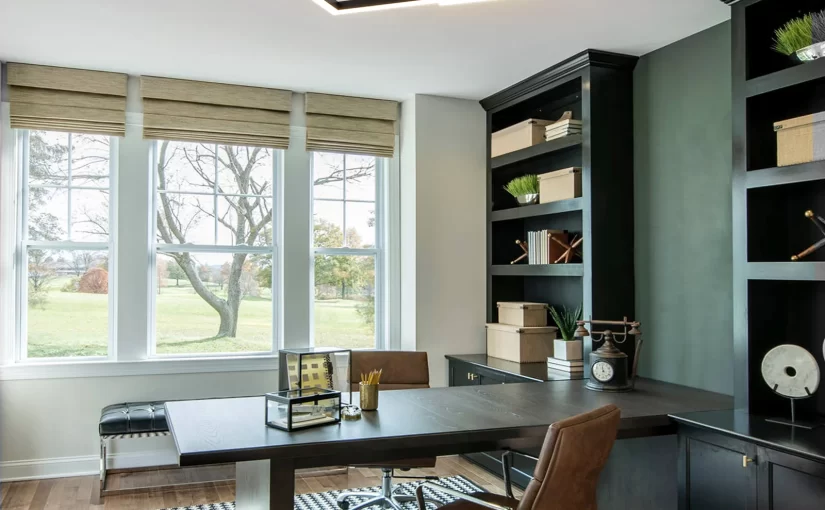Factors to Consider for Home Office Lighting
Choosing the right lighting for your home office is crucial. It can affect your mood and productivity. Consider these home office ceiling lighting ideas to find the right solution for your space.
Space Size and Area Illumination
Consider the size of your home office first. Large spaces may need more light fixtures. Think about which areas need light. A small table may need just a desk lamp, while a large room might require ceiling lights.
Types of Lighting and Appropriate Fixtures
Decide between ambient, accent, and task lighting for your needs. For ambient light, chandeliers are good. Pendant lights work well for accent lighting. Choose fixtures based on the lighting type.
Optimal Hanging Height for Fixtures
The hanging height of light fixtures matters. Typically, place fixtures 30-36 inches above your desk for optimal illumination. For higher ceilings, consider flush mount lights to save space and avoid low-hanging fixtures.
Top Ceiling Lighting Ideas for Home Offices
Selecting the perfect ceiling lighting is essential for enhancing both the functionality and aesthetics of your home office. Here, we explore popular styles that can transform your workspace into a well-lit and inviting area.
Industrial Ceiling and Pendant Lights
Industrial style lighting is perfect for a modern home office. These fixtures often combine metal finishes with minimalist designs to create a sharp, urban look. Options include wrought iron pendant lights or metal cage ceiling lights, which not only illuminate your workspace effectively but also add an element of architectural design.
Modern Globe and Glass Pendant Lights
For a sleek and contemporary office, consider globe and glass pendant lights. These lights often feature clean lines and artistic designs, with options like frosted glass or clear geometric shapes. They provide a diffuse light that can brighten up a modern workspace without being too harsh.
Farmhouse and Rustic Style Fixtures
Farmhouse and rustic fixtures often use materials like wood and distressed metal to provide a cozy, vintage feel. Chandeliers with wooden beads or metal pendants with an antique finish can add a warm and inviting atmosphere to your office, perfect for a comfortable working environment.
Dimmable and Recessed Lighting Options
Dimmable and recessed lights offer versatility and control over your office lighting, allowing you to adjust the brightness based on the time of day or the task at hand. Recessed lighting provides a clean, streamlined look, while dimmable features permit you to reduce eye strain during long hours of work.
Each of these lighting types can help transform your home office into an efficient and pleasant working space by catering to different needs and styles.
Installation Tips for Home Office Lighting
Proper lighting can enhance your work productivity and mood. Here are some tips to select and position lighting fixtures that will brighten up your home office.
Choosing the Right Fixture Size
The size of your lighting fixture should match your office space. Avoid oversized lights in small rooms; they overwhelm the area. For larger rooms, use multiple fixtures to distribute light evenly. Check the fixture dimensions before purchasing to ensure a good fit.
Understanding Light Intensity and Positioning
The brightness and position of your lights greatly affect their usefulness. Too bright may cause glare; too dim could strain your eyes. Test different bulbs to find the comfortable intensity for you. Position lights so they don’t create shadows on your work area. Ensure the main light source is above or in front of where you sit. Consider adjustable fixtures for optimal light control.
Enhancing Home Office Ambiance
Good lighting plays a key role, but ambiance involves more. Combine both natural and artificial sources to create a balanced, inviting space.
Combining Natural and Artificial Light
Take advantage of daylight to boost mood and save energy. Large windows can help. Pair natural light with LED lamps for evening work. Position artificial lights to minimize shadows and glare on your computer screen.
Optimal Use of Color and Material
Choose light colors for walls to reflect light and make the room feel airy. Opt for materials that complement your desk and decor. Metals add a modern touch; woods bring warmth. Consider the texture of your fixtures too. Smooth, glossy surfaces tend to reflect light, while matte finishes absorb it. Mix textures to add depth to your office design.
FAQs on Home Office Lighting
Brightening Tips and Fixture Types
To brighten your home office, consider several tips. Use a mix of lighting fixtures to cover the space evenly. Allow natural light to enter whenever you can. Paint walls with soft colors to reflect light better. Combine ambient and accent lighting for full coverage. For fixture types, there are many suitable options. Choose industrial ceiling lights for a sleek look. Try modern pendant lights for a stylish vibe. Farmhouse fixtures add warmth to your space. Opt for dimmable and recessed lights for control.
Overhead Lighting for Computer Work
Overhead lighting is crucial when working on a computer. It reduces glare and avoids eye strain. Ceiling lights are a good choice; pick one that’s not too bright. You can also use pendant lights; ensure they hang high enough to prevent glare. Chandeliers work well for larger spaces. Remember to pair these overhead lights with task lamps for focused work. This combination provides balanced lighting and helps protect your eyes while you work.
The Right Ceiling Lighting for A Home Office
Choosing the right ceiling lighting for a home office can have a significant impact on the overall atmosphere and functionality of the space. Here are some ideas for home office ceiling lighting that can help create a comfortable and productive work environment:
- Recessed Lighting: Recessed lighting is a popular choice for home offices as it provides a clean and modern look. It can be arranged in a grid pattern to evenly distribute light throughout the room, or strategically placed above work areas to provide focused task lighting.
- Pendant Lights: Pendant lights can add a stylish and decorative element to a home office while providing ample illumination. They come in a variety of styles and designs, allowing for personalization based on the overall aesthetic of the space.
- Track Lighting: Track lighting is a versatile option for home offices, as it allows for adjustable and directional lighting. This can be particularly useful for highlighting specific areas of the room, such as a desk or a reading nook.
- Flush Mount Fixtures: Flush mount fixtures are sleek and space-saving, making them a great choice for smaller home offices. They provide a subtle and uniform light that can brighten the entire room without overwhelming the space.
- Skylights: If natural light is preferred, skylights can be a fantastic addition to a home office ceiling. They can bring in ample daylight, creating a well-lit and inviting work environment while reducing the need for artificial lighting during the day.
- Dimmable Lights: Installing dimmable ceiling lights can provide flexibility in adjusting the lighting level based on the time of day, task at hand, or personal preference. This can help create a more comfortable and productive workspace.
Conclusion
When selecting ceiling lighting for a home office, it’s essential to consider the specific needs and preferences of the individual using the space. Whether it’s focused task lighting, ambient light for overall illumination, or a combination of both, the right choice of ceiling lighting can greatly enhance the functionality and aesthetics of a home office.











































